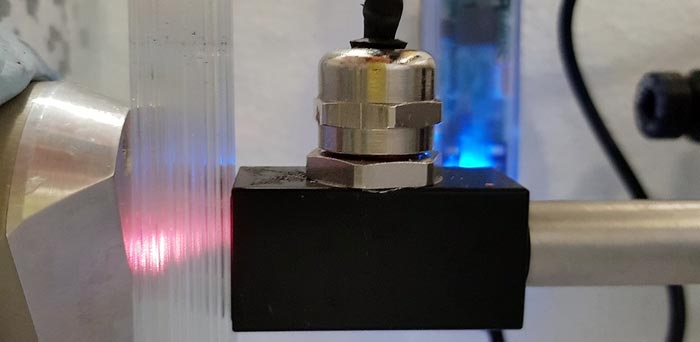Lung model proves viability of spectroscopy technique

Lung phantom lab bench setup with capillary array and GASMAS probes.
Courtesy of A. Pacheco, TNI
Lung model mimicking complex anatomy may enable air volume assessment.
Take a nice, deep breath. Now imagine your lungs: myriad airways like branches, each with tiny alveoli like leaves. This alveolar structure is key to the absorption of oxygen and excretion of carbon dioxide that we call “breath.” As we breathe, the volume of gases in the lungs is continually changing with varying degrees of inhalation and exhalation. These volumes are medically important for clinical assessment and diagnosis of respiratory pathologies.
A light-based technology known as gas-in-scattering-media absorption spectroscopy (GASMAS) may allow noninvasive optical sensing of respiratory volumes. Using tuneable diode laser spectroscopy, GASMAS turns optical signals into information for measuring gas concentration. Reference models, known as “phantoms,” afford relevant features that help biomedical optics researchers to identify technical challenges and potential applications of GASMAS technology.
As reported in the Journal of Biomedical Optics, scientists at Tyndall National Institute (TNI) in Ireland recently developed a lung phantom that mimics the optical properties and structure of the lung, including the tiny alveoli. The complexity of alveolar anatomy has meant that previous state-of-the-art lung phantoms have neglected it. The work done with this novel lung phantom demonstrates the feasibility of GASMAS to sense changes in gas volume in a controlled environment mimicking lung tissue.
Previous work toward clinical use of GASMAS for respiratory healthcare has focused on neonates, because the thickness of protective organs surrounding their lungs is within the limits of penetration depth for near-infrared light. According to first author Andrea Pacheco, a PhD student in the Biophotonics@Tyndall Group, the extension of GASMAS technique beyond neonates will depend on advances in miniaturization and integration of pulmonary endoscopes with GASMAS probes. “A further step in that direction could be to arrange two miniature GASMAS probes in an endoscope-like geometry and use our phantom to determine the signal quality and optimum source–detector separation,” she says. Pacheco and her coauthors show the basic principles involved in recreating lung tissue. Future researchers can vary the dimensions or density of the gas pockets simply by designing a new capillary holder and using capillaries with different inner radii.
Lung phantom challenges
To mimic alveoli, the novel lung phantom developed by the TNI Biophotonics team features a system of capillaries that can be variably and progressively filled with liquid that matches the optical properties of lung tissue, allowing incrementally variable pockets of air that mimic air-filled alveolar sacs. Light transmission corresponds to the capillary content in a way that’s analogous to lung inflation and deflation. This all takes place within a carefully controlled environment that mimics the humidity and temperature of the body, typically maintained at ~37 degrees Celsius.
According to Pacheco, the challenges involved in creating a relatively complex model of the lung for clinical use required significant investments of time and energy: “The clinical translation of existent technologies is tremendously challenging! The work related to this article started two years ago.” The most difficult part of the work was the need to mimic body temperature and relative humidity in a controlled manner.
Pacheco says, “It was frustrating simply trying to maintain a temperature of 37 degrees Celsius inside a bottle half-filled with water. No matter what I tried, I did not manage to do two consecutive GASMAS measurements with the same (or at least similar) parameters. And if this was just a bottle, how was I supposed to move from there to recreate lung tissue?”
Pacheco brought the problem to a meeting with the Biophotonics team at TNI, including Brian C. Wilson of University of Toronto, who was visiting the institute at the time. “After brainstorming, the path to making a lung-tissue phantom seemed to be feasible. The unique skills of each of the co-authors combined with our hard work to pay off,” says Pacheco.
Read the open access article by Andrea Pacheco et al., “Lung tissue phantom mimicking pulmonary optical properties, relative humidity, and temperature: a tool to analyze the changes in oxygen gas absorption for different inflated volumes,” J. Biomed. Opt. 27(7), 074707 (2021), doi: 10.1117/1.JBO.27.7.074707
Journal: Journal of Biomedical Optics
DOI: 10.1117/1.JBO.27.7.074707
Method of Research: Experimental study
Article Title: Lung tissue phantom mimicking pulmonary optical properties, relative humidity, and temperature: a tool to analyze the changes in oxygen gas absorption for different inflated volumes
Article Publication Date: 1-Nov-2021
Media Contact
Daneet Steffens
SPIE–International Society for Optics and Photonics
daneets@spie.org
Office: 360-685-5478
All latest news from the category: Medical Engineering
The development of medical equipment, products and technical procedures is characterized by high research and development costs in a variety of fields related to the study of human medicine.
innovations-report provides informative and stimulating reports and articles on topics ranging from imaging processes, cell and tissue techniques, optical techniques, implants, orthopedic aids, clinical and medical office equipment, dialysis systems and x-ray/radiation monitoring devices to endoscopy, ultrasound, surgical techniques, and dental materials.
Newest articles

Bringing bio-inspired robots to life
Nebraska researcher Eric Markvicka gets NSF CAREER Award to pursue manufacture of novel materials for soft robotics and stretchable electronics. Engineers are increasingly eager to develop robots that mimic the…

Bella moths use poison to attract mates
Scientists are closer to finding out how. Pyrrolizidine alkaloids are as bitter and toxic as they are hard to pronounce. They’re produced by several different types of plants and are…

AI tool creates ‘synthetic’ images of cells
…for enhanced microscopy analysis. Observing individual cells through microscopes can reveal a range of important cell biological phenomena that frequently play a role in human diseases, but the process of…





















